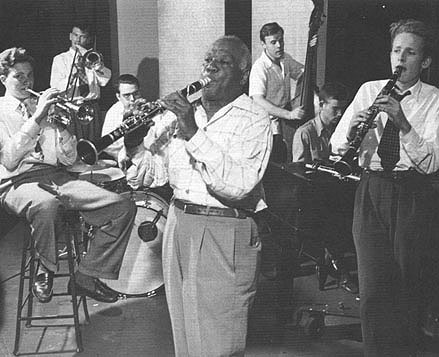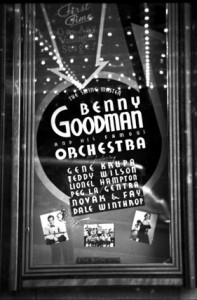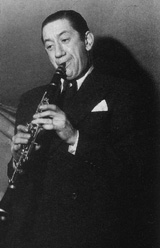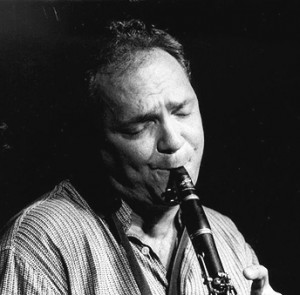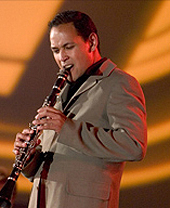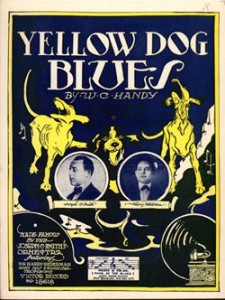For many Americans, their only experience with the clarinet has been through high school marching and concert bands that often use clarinet sections of up to ten players. Yet in the early half of the 20th Century the clarinet was an essential ingredient in jazz and popular music. Faded tintypes of Buddy Bolden's historic band taken in 1895 show two clarinetists in his line up. The emotionally 'hot' New Orleans clarinet sound was an essential ingredient of jazz from its very beginning.
In the classic traditional New Orleans jazz band the clarinet joins with the cornet and trombone in what has come to be called “collective improvisation,” or ensemble polyphony—“many sounds” or voices. The role of the clarinet in this setting is to provide a detailed, filigreed counter melody, which serves to outline the chords of the tune and thus “flesh out” the harmony of the unfolding musical narrative of the song.
Clarinet Heroes
New Orleans produced the first
great soloists of jazz clarinet,
among them Johnny Dodds, Jimmie
Noone and Sidney Bechet—who also
pioneered the related soprano
saxophone. King of Swing Benny
Goodman cited Dodds and Noone as
his musical models while growing
up in 1920s Chicago.
Goodman and his rival Artie Shaw took the basic concept of the traditional New Orleans sound and applied to it the tools of classical technique and sound production. The result was the advancement of the art of swinging jazz clarinet to new heights, seldom—if ever—surpassed to this day. Other players of the era, including Pee Wee Russell and Edmond Hall, built upon New Orleans roots by exploring and extending the blues vocabulary of the instrument.
Both Goodman and Shaw were the most popular big-band leaders of their day and superstars of show business; as a result the jazz clarinet sound today is often identified with the Swing bands of the 1930s and 40s. A decade later the clarinet had fallen out of style with more modern forms of jazz and the saxophone became the pre-eminent reed instrument of mainstream jazz bands.
This week on
Riverwalk Jazz
The Jim Cullum Jazz Band offers
an exploration of great pre-WWII voices
of jazz clarinet with the help
of prominent contemporary
exponents of the 'old school.'
Evan Christopher, Bob Wilber,
Kenny Davern and Ken Peplowski
perform with the Band and talk
about their mentors and
influences.
Evan Christopher, who studied the origins of the clarinet in early jazz at Tulane University, talks with host David Holt about the contribution of Lorenzo Tio, a clarinet master renowned for teaching classical technique to the first generation of New Orleans jazz clarinetists. Evan talks about meeting Tio's daughter, Rose Tio, and plays a tune associated with Lorenzo Tio called, "Red Man Blues."
Bob Wilber was a teenager in the 1940s when he became the star pupil of Sidney Bechet. Bob made records with Bechet and even lived in his household. But like all our guests this week, Benny Goodman looms large in Wilber’s firmament of musical heroes. And Wilber performs his own high-octane composition, a tribute to Goodman called “BG.”
Kenny Davern has been lauded as one of a handful of great clarinetists inspired by older styles. Davern came into his own playing in small combos in Greenwich Village clubs in the 1950s. In an interview recorded in 2005 he talks about his mentor, Pee Wee Russell, a consummate small-group player famous for the growls, squeaks and swoops of his inventive playing style.
Ken Peplowski began his musical career in grade school in Cleveland, playing clarinet in a polka band. Decades later he was a member of Benny Goodman’s last band featured in the 1985 PBS TV special, Let’s Dance. 'Peps' talks about what it was like performing with Goodman and how New Orleanian Barney Bigard influenced his playing.
Photo credit for home page teaser image: JCJB Clarinetist Ron Hockett. Photo by Jennifer Whitney 2009
Text based on Riverwalk Jazz script by Margaret Moos Pick © 2010


